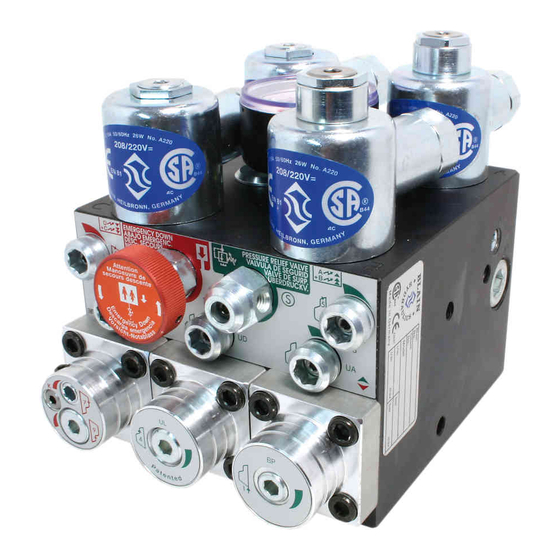Blain Hydraulics EV100 Series Instrukcja serwisowa - Strona 6
Przeglądaj online lub pobierz pdf Instrukcja serwisowa dla Jednostka sterująca Blain Hydraulics EV100 Series. Blain Hydraulics EV100 Series 16 stron. Elevator valve

EV 100 Service Manual
3. Up Deceleration
With coil B still disconnected. Energise motor and coil A (normal up-level call).
The car will travel upwards at leveling speed. Turn No. 3 in until the car starts to up level faster, then
turn No. 3 out until the original leveling speed is observed. Reconnect coil B and place a normal up call.
Observe the deceleration of the car. If it is too long, turn No. 3 out ¼ turn; if it is too short, turn No. 3 in ¼ turn.
Repeat until deceleration is satisfactory. Deceleration time should be about 2,5 secs.
5. Up Soft Stop
Disconnect coil A. Energise Motor.
The car should not move. Turn No. 5 in until the car starts upwards then turn No. 5 out until the car stops.
Reconnect coil A. Energise Pump-Motor and A. The car will travel upwards at leveling speed.
Lift A coil by hand briefly and observe the stopping of the car. If the stop is too hard turn No. 5 in ¼ turn.
If the stop is too soft, turn No. 5 out, ¼ turn. Repeat until the stop is satisfactory.
S Pressure Relief Valve
Turn S screw out until about 2 mm of the screw head is showing. Close the ball valve in the cylinder line
and open the manual lowering H to lower valve pressure down to zero. Place an up call, energising motor
and coils A and B. The relief pressure will show on the pressure gauge.
To increase the relief valve setting, turn S in.
To decrease the relief valve setting, turn S out, then open the manual lowering for ½ second with the pump
still running to release locked-in pressure, before observing the pressure gauge reading.
Down Travel (empty car)
PRE-SETTINGS
Adjustment No. 6 all the way in then 4 turns out.
Adjustment No. 7
Adjustment No. 8 all the way in then 2 turns out.
Adjustment No. 9
8. Down Deceleration
Place down call (coils C and D energised).
As the car approaches full speed, remove coil D by hand briefly from the solenoid and observe the deceleration of
the car. If the deceleration is too long, turn No. 8 out ¼ turn; if it is too short, turn No. 8 in ¼ turn.
Repeat until deceleration is satisfactory. Deceleration time should be about 2,5 secs.
6. Down Acceleration
Turn No. 6 all the way in. Place down call (coils C and D energised).
The car will not move. Turn No. 6 out slowly until the car accelerates downwards.
If the acceleration is too long, turn No. 6 out ¼ turn. If it is too short, turn No. 6 in ¼ turn.
Acceleration time should be about 2,5 secs.
7. Down Full Speed
Place down call (coils C and D energised).
Observe full down speed. Turn No. 7 in for slower, out for faster speed.
9. Down Leveling Speed
Disconnect coil C. Place down call (D energised).
Observe down leveling speed. Turn No. 9 in for slower, out for a fast down leveling speed.
Recommended speed 6 cm/sec.
H Emergency Lowering
The manually operated emergency down speed and the D coil operated down leveling speed are the same.
Down Stop
When solenoid D is de-energised with solenoid C remaining de-energised, the car will stop according to the setting
of adjustment 8 and no further adjustment will be required.
KS Slack Rope Valve
The KS is adjusted with a 3 mm Socket Key by turning the screw K in for higher pressure and out for lower
pressure. With K turned all the way in, then half a turn back out, the unloaded car should descend when the D
solenoid alone is energised. Should the car not descend, K must be backed off until the car just begins to descend,
then backed off a further half turn to ensure that with cold oil, the car can be lowered as required.
Oct 02
BLAIN HYDRAULICS GmbH Boellinger Hoefe D-74078 Heilbronn Tel. +49 7131 28 21-0 Fax +49 7131 485216 www.blain.de [email protected]
Printed in Germany
Quick adjustment
procedure
3 mm under the flange face.
level with flange face.
3 mm Socket key
5 mm
3 mm
5 mm
EN ISO 9001
4
